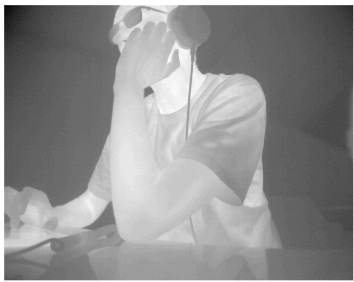Connecting the cameras
Connecting Thermal cameras
In addition to standard visual cameras, this solution supports natively infrared thermal cameras from e.g Teledyne FLIR.
Thermal/IR cameras contain an infrared bolometer sensor array.
For example, the FLIR AX5 camera has 640 sensor elements horizontally, and 512 vertically, producing a 640x512 imager array output. Each ‘pixel’ in the raw data contains radiometric information.
The recommended way to use this client is to set the cameras in ‘temperature linear’ mode. With that mode enabled, it is possible to calculate the radiometric temperature value per pixel. The raw data can be acquired in 8 or 14 bits’ dynamic range. By default, 14 bits will be used in order to get the most accurate data. The 14-bits raw data can then be converted to Kelvin, Fahrenheit or Celsius values for each pixel. To summarize, the raw data produced by the FLIR AX5 camera, as an example, is a 1-dimensional array, with 327,680 elements (640 x 512), with each element containing a 14-bit value (0 to 16383) which can be converted to K, F or C with a simple formula, for example in BigQuery.
The VIAI Edge client application has three data acquisition modes, selectable with the --mode switch: none, single and continuous:
nonedo not acquire any data. Used primarily to read or write camera configurationssinglewhen executed, the client connects to the camera, acquires the IR sensor array data once, and optionally processes the data according to command-line switches detailed belowcontinuousthe client runs in an eternal loop, acquiring new data and processing it until the client exits
Acquiring IR raw data to generate binary files
The VIAI Edge client application supports writing the raw 14-bit IR sensor values to a binary file. The binary file format consists of the following python construct fields:
p = Struct(
'device_id' / PascalString(VarInt, "utf-8"),
'ts' / PascalString(VarInt, "utf-8"),
'temp_format' / PascalString(VarInt, "utf-8"),
'temp_avg' / Half,
'temp_min' / Half,
'temp_max' / Half,
'temp_array' / GreedyRange(Short))
The file naming convention consists of the device_id, plus a datetime stamp (milliseconds since epoch) so that the camera, and the creation time of the file can be easily detected.
Each row in the binary file consists of one complete IR sensor temperature linear dump, with metadata such as the camera ID, timestamp, and pre-calculated avg, min and max temperature values in the desired format (C|F|K). This data can be then streamed via Cloud Pub/Sub to other Google Cloud services (for example BigQuery) for analysis or additional ML model training.
The client contains a python encoder function that can write the raw IR data to the binary file format and a python decoder that can be used to read the binary files and store the IR array raw data back in Python numpy arrays.
Run on Edge Server
-
In the edge server, open a shell to the camera utility container
kubectl exec -it viai-camera-integration -- /bin/bash -
To acquire one IR sensor array dump and write it to a binary file in the
/var/lib/viai/camera-data/output folder, run:python3 camera_client.py --protocol genicam --gentl /var/lib/viai/camera-config/<your-camera-gentl-file> \ --cfg_write --cfg_write_file <your-camera-required-settings>.cfg --device_id <camera-id> --raw_write \ --mode single --raw_write_path /var/lib/viai/camera-data/ -
Alternatively, to start continuous writing of sensor data to disk, execute the client in continuous mode, without any delay between the loops:
python3 camera_client.py --protocol genicam --gentl /var/lib/viai/camera-config/<your-camera-gentl-file> \ --cfg_write --cfg_write_file <your-camera-required-settings>.cfg --device_id <camera-id> --raw_write \ --raw_write_path /var/lib/viai/camera-data/ --mode continuous --sleep 0
You can change the destination directory with the --raw_write_path parameter.
Acquiring IR raw data to generate image files
The VIAI Edge client also supports generating images from the IR raw sensor array data.
You can output both raw binary files and images at the same time, if you enable both of the respective command-line switches.
IR images do not have any color. They contain a temperature brightness value for each pixel. Technically the most accurate way to represent this as an image is to turn the raw data into grayscale images, with the available temperature range mapped to the image’s dynamic range.
Such as this example:

To acquire a constant stream of data, and write it to 10 PNG files and then exit, run the following command:
python3 camera_client.py --protocol genicam --gentl /var/lib/viai/camera-config/<your-camera-gentl-file> \
--cfg_write --cfg_write_file <your-camera-required-settings>.cfg --device_id <camera-id> --img_write \
--img_write_path /var/lib/viai/camera-data/ --mode continuous --sleep 0 --count 10
With the IR camera set up, you can start to Collect images for training in the next section.